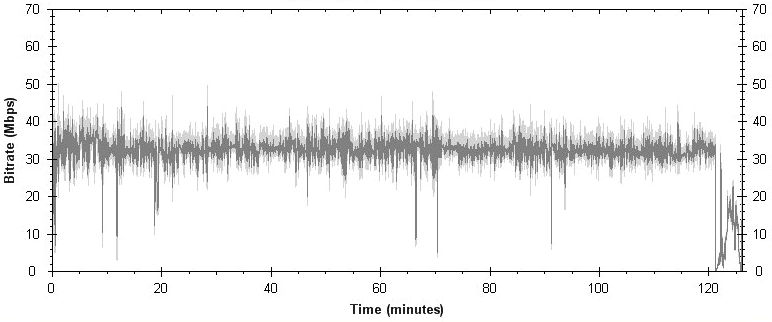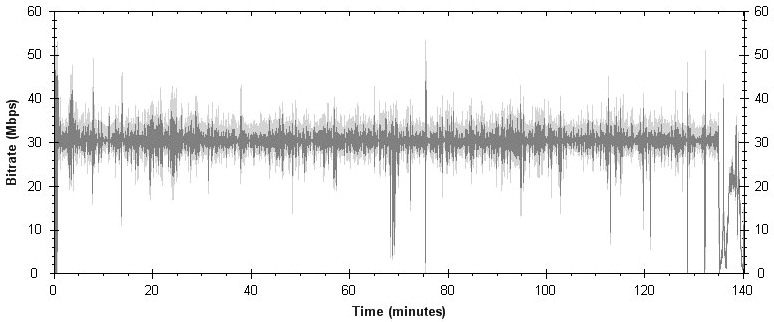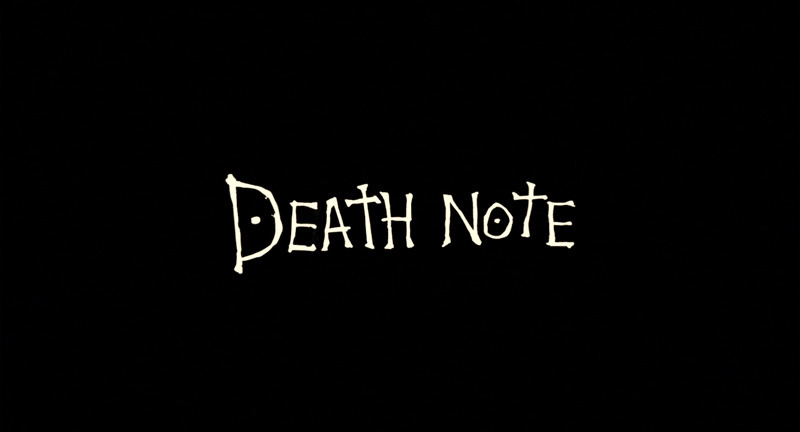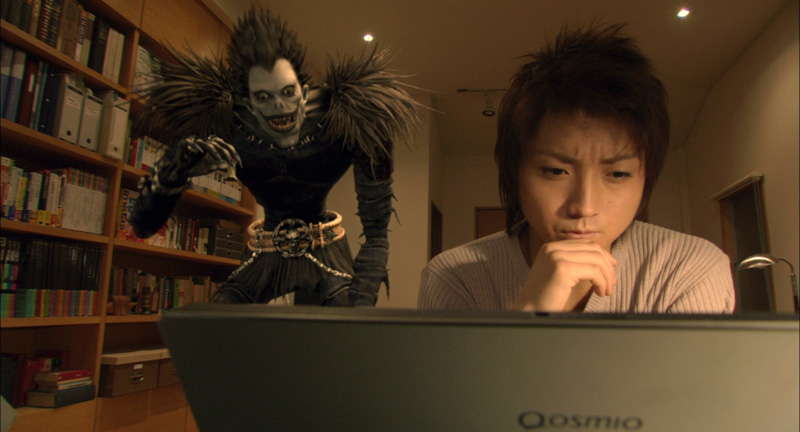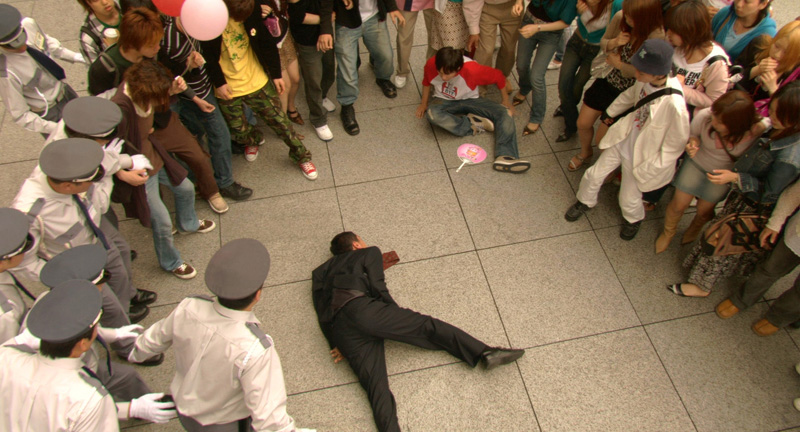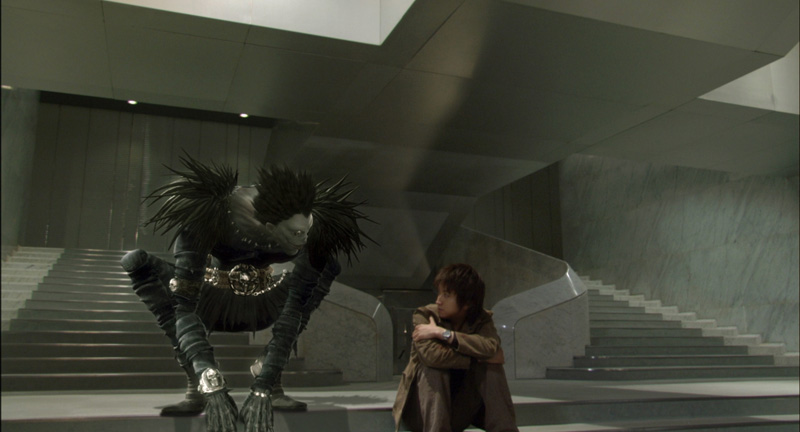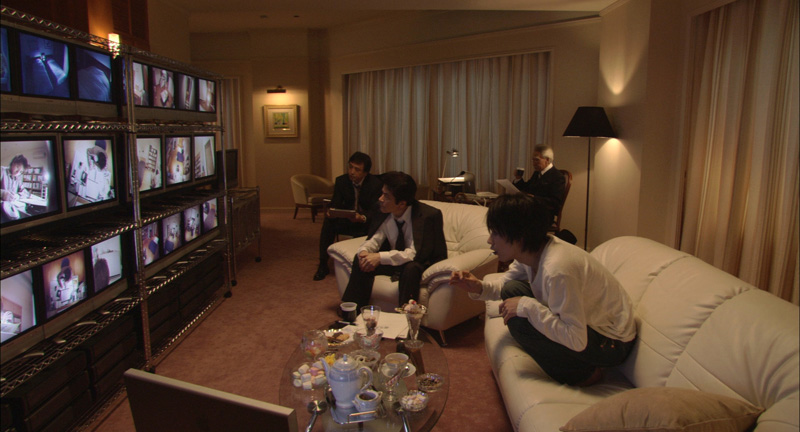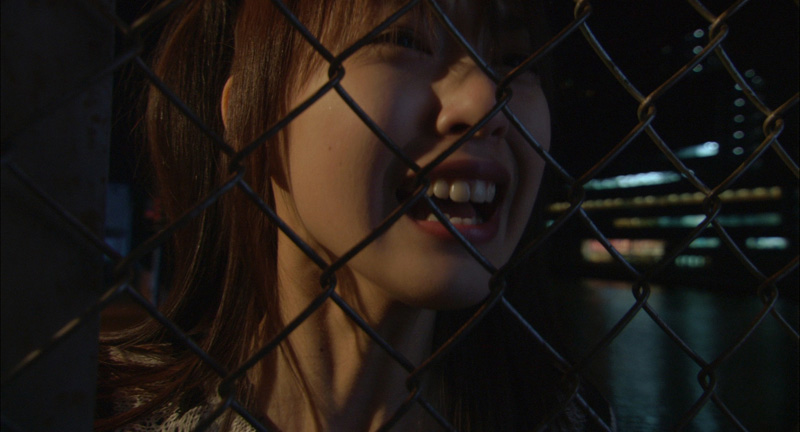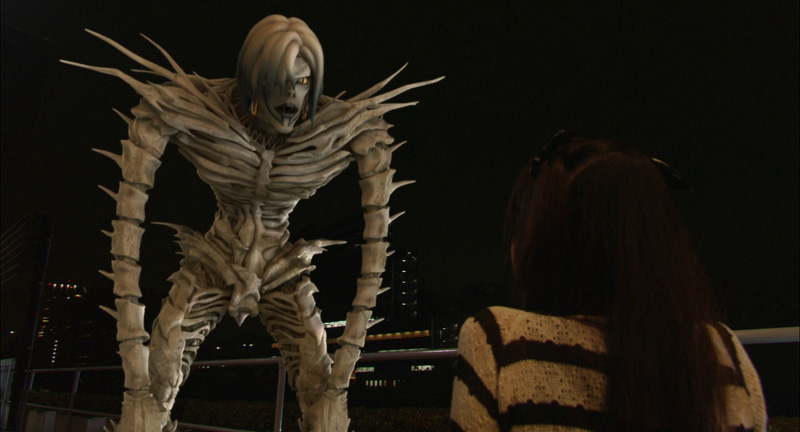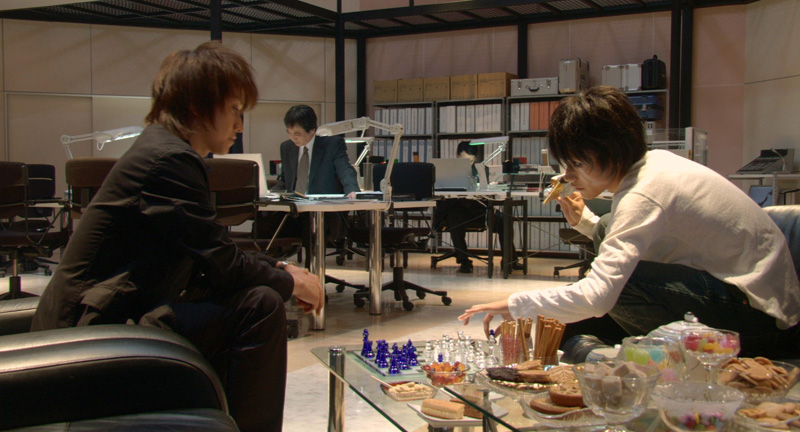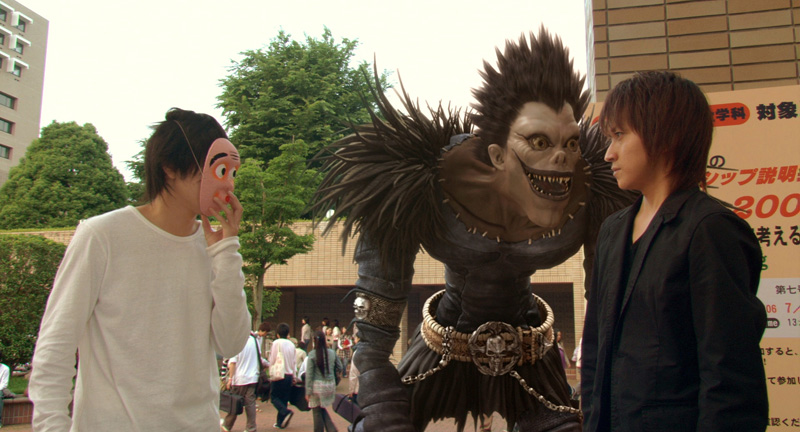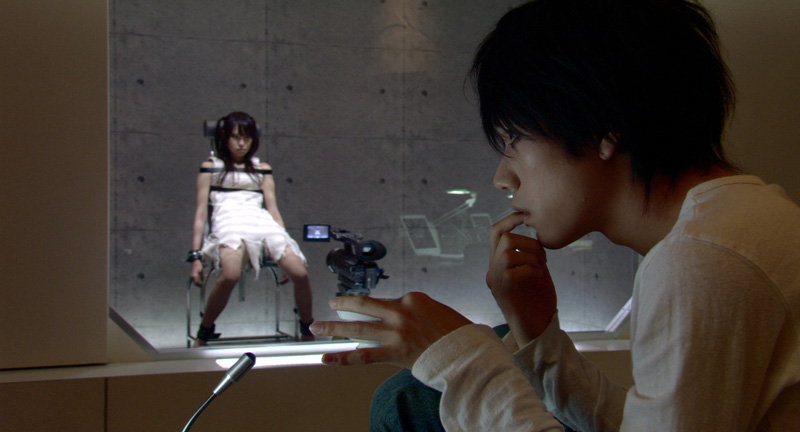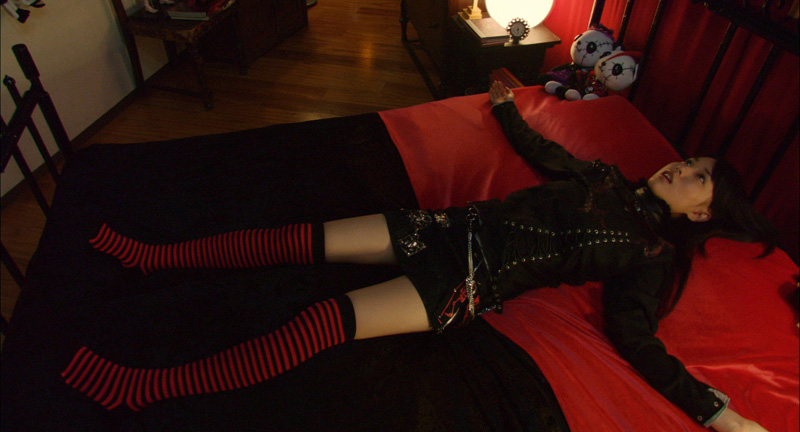Review by Leonard Norwitz
Production:
Theatrical: Death Note Film Partners
Blu-ray: VIZ Pictures
Disc:
Region: 'A' (B+C untested)
Runtime: 4:26:14 (total 2 discs)
Disc Size: 36,890,199,340 & 38,824,217,100 bytes
Feature Size: 35,832,259,584 & 37,838,728,896 bytes
Video Bitrate: 31.58 & 29.70 Mbps
Chapters: 21
Case: Blu-ray Amaray case w/ flippage
Release date: August 24th, 2010
Video:
Aspect ratio: 1.78:1
Resolution: 1080P / 23.976 fps
Video codec: MPEG-4 AVC Video
Audio:
DTS-HD Master Audio Japanese 1926 kbps 5.1 / 48 kHz / 1926
kbps / 16-bit
DTS-HD Master Audio English 2210 kbps 5.1 / 48 kHz / 2210
kbps / 16-bit
Subtitles:
English, English (signs only), none
Extras:
• Death Note: Behind the Scenes (49:59)
• Death Note II: Behind the Scenes (49:59)
• VIZ Pictures Presents (6:08)
Description: As titled, “The Death Note Collection” is
misleading at best. To start with, two movies can hardly be
construed to be a “collection.” More important, Death Note
and Death Note II are not so much feature film and sequel,
but parts 1 and 2 of a single film – a saga, if you will.
They were released in Japan only a few months apart on June
17 and November 3, 2006. The ending of “The Last Name” wraps
things up yet offers the possibility of a sequel. There is
in fact one unofficial “spin-off” sequel (“L Change the
World” written by Kiyomi Fuji & Hirotoshi Kobayashi and
directed by Hideo Nakata) that has not generated much
critical enthusiasm despite the presence of Ken’ichi
Matsuyama reprising his role as “L.”
The Film:
7<8
“Power corrupts, and absolute power corrupts absolutely.”
Light Yagami is a good student and the son of a respected
policeman, He wants to be like his father, but is distracted
and disenchanted with a legal system that permits criminals
to slip through its fingers. The creators of Death Note have
just the ticket for one such as Light: they bypass the need
for a Dexter Morgan altogether with the invention of two
devices: a shinigami, or God of Death, and his notebook that
allows a human to write the names of those he or she wants
dead, and: Voila! Dead they shall be in just 40 seconds.
There are conditions and rules, but they are readily met:
The first is that not only the name of the victim must be
entered, but the writer must be able to visualize their face
as well - a safeguard to prevent everyone with the same name
to fall prey to the dictates of the writer. As for the name
- it has to be the real name of the person visualized.
That’s the idea anyhow.
So, just to clarify what is obvious to us but not to the
investigators once criminals start dropping like proverbial
flies: the writer writes the order, but the God of Death
executes it. So, even if by some chance the police have in
custody the very author of the executions, they would be
baffled by how the killings actually occur since the suspect
would not be seen to so much as lift a finger. But that’s
only because they would not yet have grasped the idea of
supernatural forces at work.
Death Note has several elements that distinguish it from the
garden variety ghostly killer movies. For one, we never see
that hand of a shinigami at work. People merely drop dead.
For another, and this is crucial, the God of Death behaves
as a disinterested party to the executive orders of its
writers. He does not suggest, nor does he judge. He simply
observes, making only sly comments about Light’s choices and
where all this might lead him.

The shinigami, who is visible only to the present “owner” of
the Death Book and turns up at will in all manner of places,
makes one offer that the owner of the book, in this case,
Light, finds tantalizing: He will grant the writer the
ability to know the names of anyone in exchange for half of
Light’s remaining life. Of course, Light doesn’t know how
long he’s got to start with, but the chance of playing God
with more expanded power is very seductive. This is
especially the case when Light’s nemesis, the mysterious and
awesomely talented detective “L,” is brought into the
investigation to discover who is behind the sudden deaths of
criminals - in and out of custody.
At first, young Yagami is satisfied with knocking off bad
guys, but as the police begin to close in, he feels fully
justified in taking them out as well. It’s one of those
means justifies the ends dilemmas, except that the public is
divided as to these means in the first place. Most people
appreciate that crime is down, but some are adamant that
this menace, whom they call “Kira” (the same name, I
couldn’t help but notice, as the Lord drunk with self
importance and power in the legend of the 47 Ronin,
Chushingura), is just another criminal in his lack of
respect for the rule of law, however flawed.
It is no wonder that the same culture that feels there is a
serious moral question here also spawned the Battle Royale
series (Tatsuya Fujiwara, once again), in which the
authorities, frustrated by failed attempts to reign in
unruly high school students, simply arranged for a bunch of
them to kill one each other off.
Part II, I think, is the better film, partly because of its
complexity. Those characters that survive by the end of Part
I continue. In fact, the second movie picks up just a few
frames before the first part ends. “L” has failed to
identify Kira though he has strong suspicions that he is
indeed Light. Light is still bent on destroying “L,” but the
problem all along was that Light never could learn L’s true
identity. Now that Light has been cleared of suspicion he
insinuates his way onto the very team that is investigating
Kira.
To make things even tougher for “L” and his team, there are
now two Death Gods and two Death Notes along with their
respective owners for which screenwriter Tetsuya Oishi
develops an intricate mousetrap game of wits and death
between the two “Kiras” and “L.”
My one complaint about Death Note as a whole is that there
are too many heart attacks, the default cause of death if
the owner/writer fails to specify. As long as the Death Note
offers the owner creative possibilities of destruction, why
not take advantage of them – for the cinematic possibilities
as well as for narrative plausibility? I feel Light (you
gotta love that name in this context!) would have enjoyed
the privilege. Beyond that, Part II is drowned by a lengthy
explanatory denouement that pontificates on the morality of
power. It’s really too bad, Death Note had classic
potential.
Image:
9/9
NOTE:
The below
Blu-ray
captures were taken directly from the
Blu-ray
disc.
The Japanese, more so than Chinese or Korean movie industry,
has a penchant for desaturated color that can flatten
contrast to a pale watercolor (cf:
Maborosi,
Tony Takitani
or the
Hidden Blade). I’ve never understood it, but I’m
happy to report that Death Note employs more naturalistic
contrast and color than such films. For some reason, or no
reason, Part II has a higher black level: that is, black
more nearly and more often approaches true black with more
detail available in the dark parts of the frame. On the
other hand, Rem, the second God of Death, is less vividly
manifest. Otherwise, there are no transfer issues short of a
whisper of edge enhancement on occasion.
CLICK EACH
BLU-RAY
CAPTURE TO SEE ALL IMAGES IN FULL 1920X1080 RESOLUTION
Audio & Music:
7/7
VIZ offers an English dub in DTS-HD MA that is far from
revolting, but given how truly perfect the Japanese cast is,
visually and vocally, you should not resort to it unless you
must. That said, the English cast is much the same as for
the anime series - a smart move. Dialogue and music is clear
and well proportioned, with the two Gods of Death, Ryuk and
Rem, given a ghostly reverberance in the surrounds, where
effects are placed effectively.
Extras:
6
The bonus features are contained on a separate DVD and
include behind the scenes production logs for both Death
Note movies and a promo piece for VIZ Pictures that preview
three of their coming releases (DMC: Detroit Metal City,
20th Century Boys Trilogy, and K-20 The Fiend with 20 Faces)
The making-of production logs are exactly the same length
(49:50) that take a day-by-day look at shooting,
interspersed by comments of the featured cast in a
quasi-hosting role. These are presented in decent quality
4:3 and letterboxed MPEG-2.

Bottom line:
8
I suspect that I will enjoy Death Note even more on second
viewing – in fact, I am looking forward to it. I suppose
that says something despite my criticisms and that, taken
together, the saga is almost four and a half hours. I found
the manifestation of the two Gods of Death to be beautiful
in their way – my only reservation that they tended to hop
slightly, the result of less than absolutely smooth
wirework. The entire film is very well cast, with memorable
characterizations everywhere, especially the first God of
Death, who calls himself “Ryuk” who appears much as he does
in the manga and is voiced by a self-amused Shido Nakamura,
and Ken’ichi Matsuyama’s “L” a hunchback with an insatiable
sweet tooth and an angelic face right out of anime. The
screenplay is intricate and clever and asks pertinent, if
na´ve, moral questions. Bonus features are worth watching,
so that’s another two hours to while away your life,
assuming, of course, that you haven’t traded half of it for
anything you shouldn’t.
Leonard Norwitz
September 23rd, 2010
![]()
![]()

![]()
![]()
![]()
![]()

![]()
![]()


